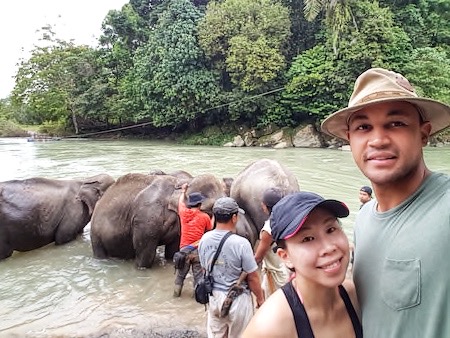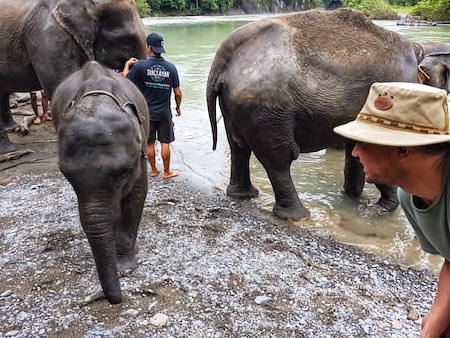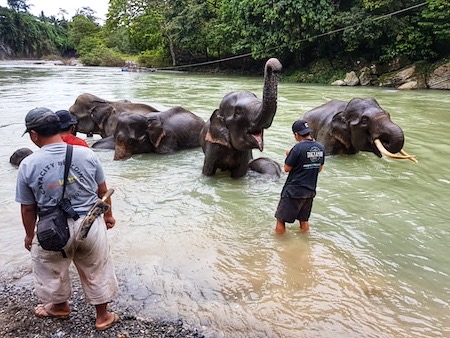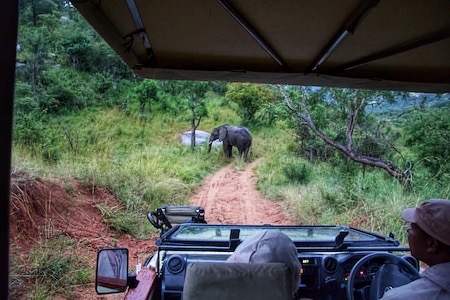
Even a small act of kindness can make a big difference in someone’s world, or in this case, an elephant’s world. Find out how you can find and support an ethical elephant sanctuary before your next trip.
We LOVE animals! Hard not to, when you’ve grown up in the beautiful country of South Africa.
We’ve obviously seen elephants before, but always from the confines of a safari car. Never did we think that it was possible to get up close and personal with elephants.
So you can imagine how ecstatic we were, when we found out that you could feed and bathe elephants in Indonesia.
The Ethical Dilemma of Wildlife Tourism
Our excitement was quickly met with mixed feelings. On the one hand, we were excited because it’s an unforgettable, once-in-a-lifetime experience for animal lovers like ourselves. But on the other hand, we were afraid of unknowingly supporting unethical wildlife organisations that were abusing animals for their personal financial benefit.
So we decided to visit a sanctuary instead. We had assumed that it would be an ethical home for wildlife if it was called a sanctuary. It was only after experiencing it for ourselves, did we realise that this was NOT always the case.
That’s what sparked us to write this guide. We realised that feeling guilty for naively supporting a fake sanctuary does not help anyone, let alone the elephants. The only way we could help change it, was by sharing our experience and creating awareness around the topic.

The Good, The Bad and The Ugly of Wildlife Tourism
One of the most popular tourist attractions across South East Asian countries such as Thailand, Indonesia, Cambodia, Sri Lanka, Myanmar and Laos, are elephant tours and elephant riding in particular. As sad as it is, many travellers are still not aware that you should not ride an elephant.
The bad news is that tourist demand is the main reason why elephants are captured and abused to service this market.
The good news is that, in the same way that tourists fuel elephant or any sort of wildlife exploitation, we also have the power to influence a positive change. We can do this together by demanding tour operators or ‘sanctuaries’ to change their ways and treat animals ethically.
Save Me For Later

How to Help Raise Awareness on Ethical Wildlife Tourism
If like us, you have unknowingly supported an unethical wildlife organisation, let’s transform that guilt and make a positive change. We cannot change the past, we can only change the future. We honestly don’t believe anyone would knowingly visit unethical organisations if they had known beforehand.
Make sure to share your story. Educate your friends and family around you to NOT partake in unethical practices like riding elephants, supporting circuses or any form of unnatural wildlife performance shows. Write a review on TripAdvisor or Google to warn other travellers, or simply share this guide.
You can read our Tangkahan Elephant Sanctuary review and learn from our personal experience.
As travellers become more educated and demand wildlife to be treated ethically, we hope that more and more wildlife operators change their ways.

How to Find Responsible Elephant Sanctuaries?
1. An Ethical Elephant Sanctuary Will Never Offer Elephant Riding
Why Elephant Riding Is Cruel
Elephants may look big and strong, but their backs are actually quite weak and not made to carry weight. That’s why you’ll never see elephants that live in their natural habitat lift anything onto their backs. You’ll see them carrying heavy objects with their trunks instead.
Some elephant ‘sanctuaries’ tell travellers that riding elephants bareback doesn’t harm the elephants. This is not true. Elephant spines are simply not designed to support the weight of humans (not even one) and doing so can lead to permanent spinal injuries.
Not only will an ethical elephant sanctuary never offer elephant riding for tourists, but neither will their mahouts ride them. (A mahout is a person who works with and tends to an elephant.)
Riding elephants with a chair or howdah is a definite no-no. Besides the extra weight (since most howdahs are designed to carry 2 people) the chair itself chafes against the elephant’s back, causing blisters that can get infected.
Bottom line to this is, don’t support any organisation that offers elephant riding even if you won’t ride the elephants when you’re there. Together, we can influence positive change by not supporting them with money.

2. Ethical Sanctuaries Will Not Offer Elephant Entertainment
Elephants Used For Entertainment Are Often Abused
If they advertise shows for watching elephants dancing, painting or performing tricks, that’s another sign that it’s not a responsible sanctuary.
Elephants that are ‘taught’ to perform are almost always maltreated. It’s the same reason why we never support zoos or circuses. Not only are these elephants kept in small cages, they are usually physically abused as well.
These operators often apply the same spirit crushing technique used to train elephants for riding, to force the elephants to perform tricks. The elephants are forced into submission in fear of being hurt.
You can help change this by telling tour operators that this is not right and not supporting their business.
3. An Ethical Elephant Sanctuary Will Limit Direct Contact With Elephants
Is Bathing Elephants Ethical?
This one was a bit hard for us to stomach, because we really enjoyed our feeding and bathing experience with the elephants in Indonesia.
We thought that if a sanctuary offered it instead of riding, that it was an ethical activity. Little did we know that even bathing elephants was considered irresponsible.
While bathing elephants itself isn’t harmful, it’s the process to get the elephants to go against their natural instinct to avoid humans that’s often unethical.
That’s why truly ethical sanctuaries usually have an observe rather than disturb approach.
This makes sense if you think about it. In nature, elephants would not normally come in direct contact with humans. So how are these operators ‘training’ elephants to bathe with unfamiliar humans?
As a traveller, you’ll never know what happens behind the scenes. Therefore, the best approach is to visit sanctuaries that encourage observation rather than direct contact with elephants.

4. Guest Numbers are Kept Low at Responsible Elephant Sanctuaries
Alongside limited direct contact, an ethical elephant sanctuary would keep the visitor numbers low. We don’t know what the exact number is, but if it feels like you’re struggling against a sea of selfie-sticks, that’s probably not a good sign.
It’s probably also worth asking how many visiting sessions the sanctuary hosts per day. Most sanctuaries we came across only allowed one or maximum two visits per day.
We weren’t able to find an exact number, but we would consider 10-15 people per visit to be reasonable. Nothing more than that.

5. An Ethical Elephant Sanctuary Will Likely Have a Volunteer Programme
Volunteering At Elephant Sanctuaries
If the sanctuary you’re planning to visit has a volunteer programme, that’s a good sign. Malpractices are much harder to hide when you have animal-loving volunteers around.
Volunteering is not only a great way to give back. It’s probably the most ethical approach to take if it’s your lifelong dream to come within closer contact to these majestic creatures.
There are many volunteer and wildlife conservation projects around the world. PodVolunteer and Volunteer World have dedicated elephant volunteer projects across Africa and Asia.
But if you’re keen to volunteer for more wildlife projects besides elephants alone, you can also check out Enkosini Eco Experience. They have general wildlife conservation projects in South Africa, Namibia and Botswana.

6. Large and Adequate Enclosures for Elephants
This is a controversial topic. Obviously the most ideal case would be for the elephants to roam in the wild, completely free from human intervention.
Unfortunately this is not always possible. Especially in many South East Asian countries where elephants have already formed a dependent relationship with humans and mahouts. Therefore, the next best case would be for them to be treated well. As you would when your pet becomes part of the family.
Providing a large and adequate enclosure for the elephants is a very important requirement. But it can be hard to tell until you’ve physically arrive at the sanctuary. It can also be difficult to tell from photos alone. But it’s always good to check and see if there are any available photos on the organisation’s website or from visitor reviews.
The enclosures should be large enough for the elephants to roam around. It should also have sufficient water, food, shade and be completely chain-free.

7. Do Proper Research Before You Visit an Elephant Sanctuary
This is probably the most important tip and the reason why you landed on this page.
Try your best to always do proper research on the elephant sanctuary you’re planning to visit. Do not rely on tour operators to tell you the truth. Some don’t actually know. They are likely to tell you that it is an ethical elephant sanctuary because it is called a sanctuary.
Check the organisation’s website. Read up on their story, practices and, if available, their ethical animal welfare policy. Find out where their elephants come from. Are they rescued and rehabilitated elephants from captivity or the illegal animal trade? Is it a retirement home for old, retired or injured elephants? Or are they orphans that will eventually be released back into the wild?
Finally, check to see if there are any reviews on the elephant sanctuary. Search on TripAdvisor, Facebook and Google to see if anyone raised any red flags on the organisation. It will also be worth your while to compare it to this list of elephant sanctuaries by Responsible Travel as an additional measure.

Wrapping Things Up
We wrote the above tips with ethical elephant sanctuaries in mind. But you can apply these to any wildlife sanctuary you’re planning to visit.
These tips will help increase your chances of supporting ethical wildlife sanctuaries. But honestly, sometimes even doing the above can’t 100% guarantee that the organisation is ethical. That’s why it’s so important that if you discover that they’re not, to pay it forward and let others know.
You can share your experience with us via social media.
We’ve followed our own advice and shared our personal experience on the Tangkahan Elephant Sanctuary in Indonesia.

Best Ethical Wildlife Tour in South East Asia
We often get asked what our most unforgettable adventure has been. Jungle trekking in Bukit Lawang and coming face-to-face with orangutans in their wild habitat is an experience we will never forget.
Not only was it incredibly memorable, it is also 100% ethical. Make sure you read our Jungle Trekking in Bukit Lawang guide to find out why this experience tops our list.
What ethical wildlife tours have you been on? We’d love to hear about your recommendations and experiences.



